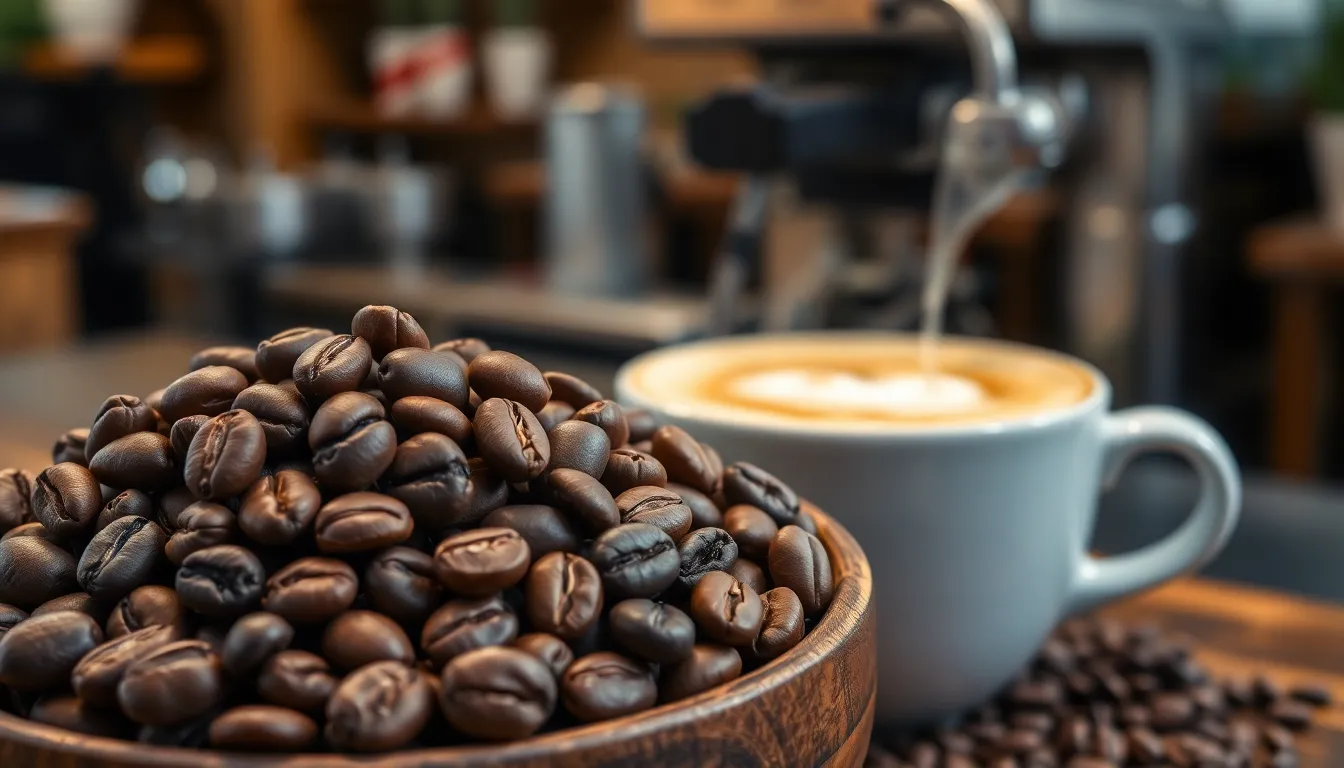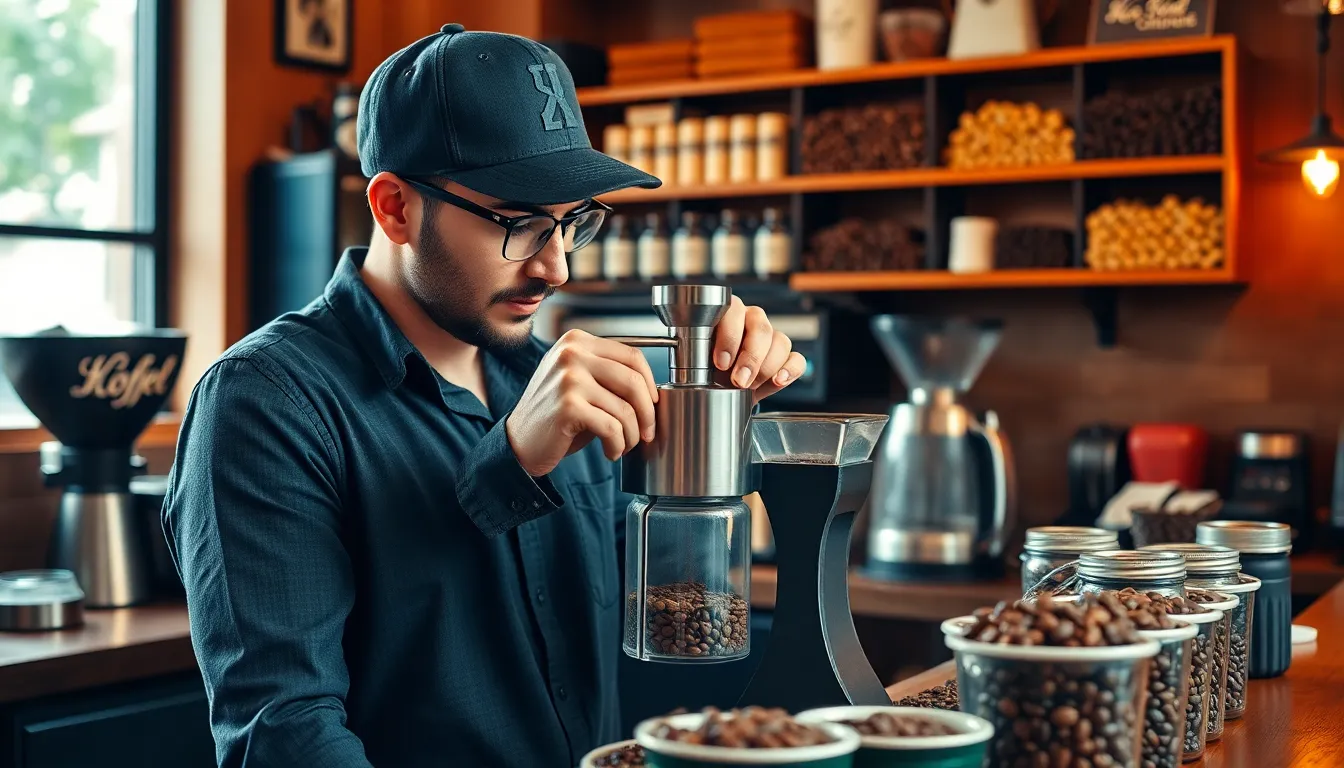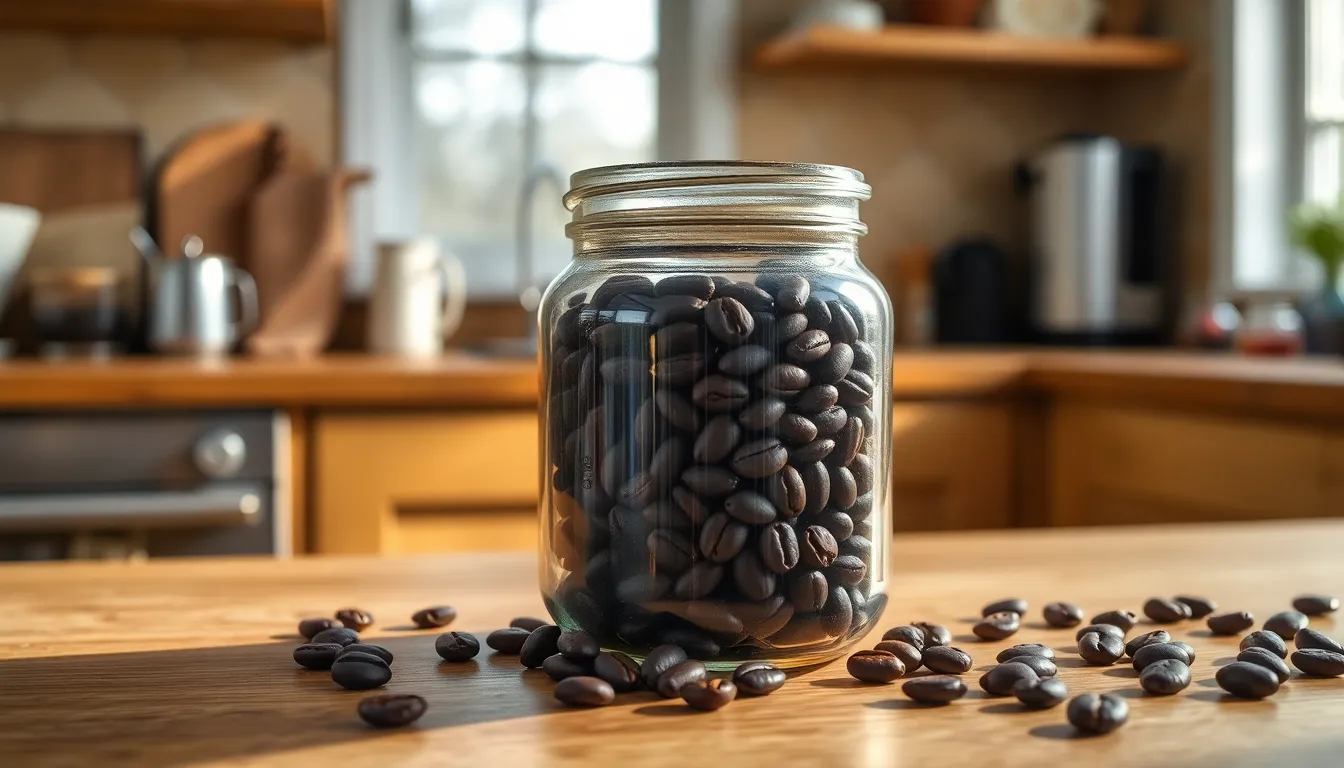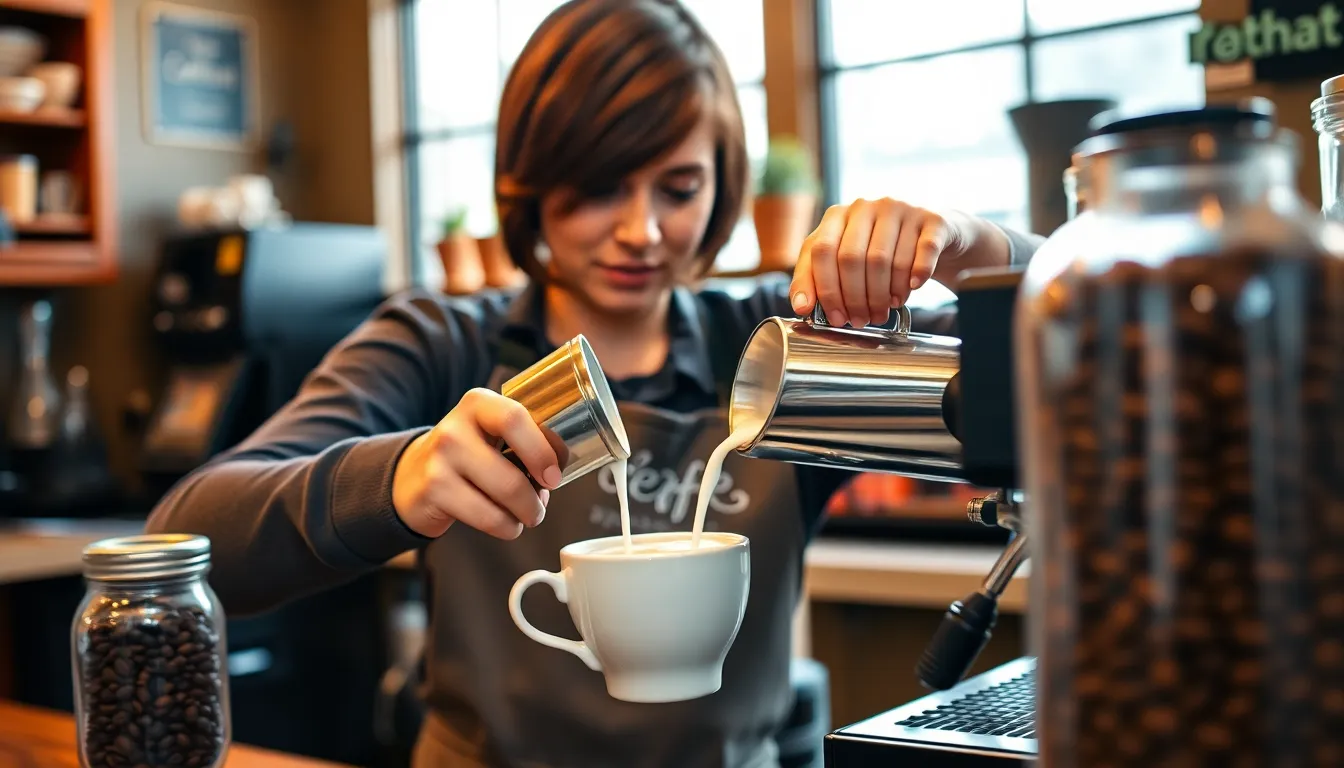Searching for the best coffee for cappuccino but feeling overwhelmed by all the options? The perfect cappuccino starts with selecting the right coffee beans—it’s the foundation that can elevate your morning ritual from ordinary to extraordinary.
When crafting a cappuccino, you need beans that can stand up to milk while maintaining their distinct flavor profile. Italian dark roasts traditionally shine in cappuccinos, offering robust chocolate and caramel notes that complement the creamy microfoam. But modern specialty coffee has expanded these horizons, with medium roasts now providing exciting flavor complexity that many coffee enthusiasts prefer. The ideal choice balances bold flavor, proper extraction, and personal preference.
What Makes a Great Cappuccino Coffee
A great cappuccino depends on several key factors working in harmony. The foundation starts with properly selected coffee beans that provide the right flavor profile to complement milk without getting lost in it. Italian-style dark roasts typically deliver the chocolate and nutty notes that shine through the milk, creating that classic cappuccino experience.
Proper extraction is equally important – the espresso base must be pulled correctly with 25-30 seconds of contact time between water and coffee grounds. This ensures the extraction of essential oils and compounds that give cappuccino its distinctive character.
The milk component can’t be overlooked either. Perfectly steamed milk at 140-150°F creates microfoam with a silky texture that integrates beautifully with the espresso. The ideal cappuccino follows the traditional ratio of 1/3 espresso, 1/3 steamed milk, and 1/3 foam, though modern variations sometimes adjust these proportions slightly.
Fresh beans make a noticeable difference in cappuccino quality. Coffee begins losing its aromatic compounds within days of roasting, so beans roasted within 2-3 weeks provide significantly better results than older alternatives. Rikki Manny, our resident coffee expert, discovered this difference firsthand when comparing cappuccinos made from beans roasted 48 hours earlier versus those three months old – “The fresh beans produced a cappuccino with vibrant notes that danced on the palate, while the older beans created a flat, one-dimensional experience.”
Quality equipment, while not strictly about the coffee itself, dramatically affects cappuccino preparation. A good espresso machine with consistent pressure and temperature control, paired with a quality burr grinder for proper particle size, transforms even decent beans into an exceptional cappuccino.
Understanding Coffee Bean Types for Cappuccino

The choice of coffee beans fundamentally shapes your cappuccino experience, influencing everything from flavor intensity to aroma and crema quality. Selecting the right bean variety can transform an ordinary cappuccino into an exceptional one, balancing the bold espresso base with the creamy milk component.
Arabica vs. Robusta for Cappuccino
Arabica beans offer a smooth, mildly acidic profile with natural sweetness that complements cappuccinos beautifully. These premium beans create a balanced flavor that works harmoniously with steamed milk, producing a velvety texture without overwhelming bitterness. Single-origin Arabicas bring refined taste notes to your cup but typically come at a higher price point.
Robusta beans, in contrast, deliver a stronger, more bitter profile with nearly double the caffeine content of Arabica. Pure Robusta can be too intense for cappuccinos, but when blended with Arabica, it contributes exceptional body, richer crema, and depth to the espresso foundation. Many Italian-style cappuccino blends incorporate some Robusta specifically for its ability to maintain flavor intensity when combined with milk.
Single Origin vs. Blends
Single-origin coffees showcase the distinctive flavor characteristics of exact regions or farms. These beans highlight unique taste notes—whether fruity Ethiopian varieties or nutty Colombian offerings—adding sophisticated complexity to your cappuccino. The terroir-exact flavors can create memorable cappuccino experiences, though some single-origins might lack the consistent balance needed for everyday drinking.
Coffee blends combine beans from multiple sources to achieve reliable flavor profiles and optimal crema formation. Medium to dark roasted blends remain the popular choice for cappuccinos as they develop rich caramelized notes that stand up to milk without disappearing. Traditional Italian espresso blends often contain 80-90% Arabica with 10-20% Robusta, creating the perfect foundation for a balanced cappuccino with pronounced chocolate undertones and persistent crema.
Many specialty cafés feature seasonal blends specifically formulated for milk-based drinks, with beans selected to maintain distinct flavor identity even when diluted with milk. These carefully crafted combinations ensure your cappuccino delivers consistent quality and memorable taste with every cup.
Top 10 Coffee Beans for the Perfect Cappuccino

Finding the right coffee beans elevates your cappuccino from ordinary to extraordinary. These carefully selected options balance flavor intensity with milk compatibility to create that perfect harmony in your cup.
Premium Italian Espresso Blends
Italian espresso blends stand as the gold standard for authentic cappuccinos. Lavazza Qualità Oro delivers a remarkably smooth profile with delicate floral notes that shine through milk. Illy Whole Bean Coffee Intenso offers that classic Italian intensity with a balanced sweetness that cuts through the creaminess of steamed milk. Segafredo Zanetti® Enzo Dark Roast provides the rich, robust foundation that traditional cappuccinos demand, with notes of dark chocolate and toasted nuts that complement the milk’s natural sweetness. Traditional Italian blends typically contain 80-90% Arabica beans for complexity and 10-20% Robusta for that distinctive crema that holds up your microfoam perfectly.
Medium-Dark Roast Options
Medium-dark roasts balance boldness with nuanced flavors ideal for cappuccinos. Stone Street Cappuccino Blend features a creamy mouthfeel with caramelized sugar notes that enhance rather than compete with steamed milk. Colipse Espresso Dark delivers bold chocolate-spice flavors that cut through milk while maintaining harmony in the cup. Ruta Maya Organic Espresso Roast creates an impressive crema while offering earthy, organic depth that pairs beautifully with the milk’s silkiness. Café Gaviña Espresso Roast Extra Fine Ground provides convenience without sacrificing the deep, complex flavors that make cappuccinos special. These medium-dark options roast beans just long enough to develop oils and sugars while preserving origin characteristics that contribute to a multi-dimensional cappuccino experience.
For consistent results, Starbucks Espresso Roast offers familiar bold notes that perform reliably with milk foam. Dolce Gusto Nescafé Coffee Pods Cappuccino Blend provides convenience for those seeking quick, mess-free preparation without compromising on that essential espresso intensity needed for balanced cappuccinos.
How Roast Levels Affect Your Cappuccino

Cappuccinos blend espresso with steamed milk and foam, creating a delicate balance where roast level plays a crucial role in determining the final flavor profile. The perfect cappuccino relies on coffee that’s strong enough to cut through milk without overwhelming its natural sweetness.
Medium Roast Characteristics
Medium roasts create cappuccinos with balanced acidity and full-bodied flavor profiles that many specialty coffee enthusiasts prefer. These beans, roasted between 347°F and 365°F, extract bright, complex flavors featuring subtle caramel or chocolate undertones. Their balanced profile maintains vibrancy even when combined with milk, making them particularly suitable for morning cappuccinos when you’re looking for a lively yet smooth coffee experience. Medium roasts provide enough assertiveness to stand up to the milk while contributing pleasant complexity rather than overwhelming intensity.
Dark Roast Benefits
Dark roasts deliver deeper, more bittersweet flavors that create remarkably rich cappuccinos with pronounced body. Roasted at temperatures between 401°F and 419°F, these beans develop smoky, intense characteristics with significantly reduced acidity. Their robust flavor profile works exceptionally well with lower shot volumes, as the intense flavors complement milk’s sweetness without introducing sharpness. Dark roasts typically yield a creamier espresso that blends seamlessly with steamed milk, creating that characteristic velvety mouthfeel cappuccino lovers crave. You’ll find dark roasts particularly satisfying if you prefer cappuccinos with bold coffee notes that remain distinctive even when combined with generous amounts of milk.
Freshness and Grind Considerations

Freshly roasted coffee beans form the foundation of an exceptional cappuccino experience. Coffee reaches its peak flavor within 1-2 weeks after roasting, containing optimal aromatic oils and compounds that significantly enhance your drink. These volatile flavor substances begin degrading immediately after grinding, making it essential to grind beans just before brewing rather than purchasing pre-ground coffee.
Your grind size directly impacts extraction quality and crema development in cappuccinos. A consistent medium-fine grind works best for espresso machines, allowing water to extract rich flavors without over or under-extracting. Too coarse a grind produces weak, sour espresso lacking body, while too fine a grind creates bitter, over-extracted shots that compromise your cappuccino’s balance.
Investing in a quality burr grinder offers precise control over particle size consistency. Blade grinders create uneven particles that extract at different rates, whereas burr grinders produce uniform grounds that extract evenly for balanced flavor. The difference becomes particularly noticeable in milk-based drinks like cappuccinos, where espresso quality forms the flavor foundation.
Storage methods also affect bean freshness and flavor retention. Airtight containers stored away from light, heat, and moisture preserve coffee’s aromatic compounds longer. Many coffee professionals recommend ceramic or opaque glass containers with one-way valves that release carbon dioxide without letting oxygen enter.
How to Store Your Cappuccino Coffee

Proper storage extends the shelf life of your cappuccino coffee beans while preserving their distinctive flavors and aromas. An airtight container provides essential protection against oxygen exposure that causes rapid oxidation and staling, compromising the rich flavors needed for a perfect cappuccino. These containers create a barrier that locks in freshness and prevents the beans from absorbing unwanted odors from your kitchen.
Finding a cool, dark place away from direct sunlight and heat sources is crucial for maintaining bean quality. Heat and light degrade the essential oils in coffee beans that carry the complex flavor notes of chocolate, nuts, and fruits that make Arabica beans ideal for cappuccinos. A cabinet away from your stove or a pantry shelf works perfectly for daily storage needs.
Contrary to popular belief, refrigerators and freezers aren’t ideal storage locations for your everyday coffee supply. The moisture inside these appliances can adversely affect bean quality, and the beans may absorb odors from other foods. Reserve freezer storage only for bulk purchases, using vacuum-sealed bags to minimize exposure to air and moisture when removing small portions.
Grinding beans immediately before brewing maximizes flavor potential in your cappuccino. Pre-ground coffee loses up to 60% of its aromatic compounds within 15 minutes of grinding, significantly diminishing the rich flavor profile needed to complement the creamy milk in your cappuccino. This fresh-ground approach ensures you’ll capture the full-bodied taste that medium to dark roast beans offer when properly extracted.
Budget-Friendly vs. Luxury Coffee Options

Budget-Friendly
Budget-friendly coffee options offer excellent value for cappuccino lovers without compromising on essential flavor qualities. Ruta Maya Organic Espresso Roast provides a balanced profile with rich undertones that shine through steamed milk, making it an affordable daily option. Starbucks Espresso Roast delivers consistent results with its caramelized sugar notes and moderate intensity, perfect for home cappuccino makers on a budget.
Coffee subscriptions and bulk purchases significantly reduce the per-pound cost while ensuring a fresh supply. Many local roasters offer subscription discounts of 10-15% off retail prices, making premium beans more accessible. Dolce Gusto Nescafé Coffee Pods Cappuccino Blend brings convenience to budget-conscious consumers, delivering pre-measured portions that create reliable results without specialized equipment.
Luxury and Premium
Luxury coffee options elevate cappuccinos with distinctive flavor profiles and exceptional quality. Colipse Espresso Dark stands out with its bold chocolate-spice undertones that create a sophisticated cappuccino experience worth the premium price. Lavazza Qualità Oro, crafted from carefully selected Arabica beans, offers smooth, floral notes with a refined acidity that perfectly complements the creamy texture of steamed milk.
Small-batch artisanal roasters provide exceptional freshness that dramatically impacts cappuccino quality. These premium beans often showcase complex flavor layers that develop beautifully when combined with milk. Illy Whole Bean Coffee Intenso delivers a velvety mouthfeel and persistent aftertaste that transforms an ordinary cappuccino into a luxurious experience. Segafredo Zanetti Enzo Dark Roast presents deep cocoa and toasted nut profiles that create an indulgent cappuccino with remarkable depth and richness.
Specialty coffee enthusiasts appreciate the traceability and unique characteristics of single-origin luxury beans. These premium options often highlight distinctive regional flavor notes that add complexity to cappuccinos, justifying their higher price point for discerning coffee lovers.
Conclusion
Choosing the perfect coffee for your cappuccino is truly a personal journey that balances tradition with your unique taste preferences. Whether you opt for a classic Italian dark roast with its bold chocolate notes or explore medium roasts with their complex flavor profiles the right beans will transform your morning ritual.
Remember that freshness matters tremendously with beans at their peak 1-2 weeks after roasting. Your equipment choices from a quality burr grinder to a reliable espresso machine play crucial roles in extracting those precious flavors.
Don’t be afraid to experiment between Arabica’s smoothness and Robusta’s strength or try both budget-friendly options and luxury beans. The perfect cappuccino awaits you at the intersection of quality beans proper extraction and perfectly steamed milk.
Frequently Asked Questions
What type of coffee beans are best for cappuccino?
Italian dark roasts are traditionally best for cappuccinos, offering rich chocolate and caramel flavors that pair well with milk. However, medium roasts are gaining popularity for their complex flavor profiles. The ideal bean balances bold flavor with proper extraction and suits your personal taste preferences. Many quality cappuccinos use a blend of 80-90% Arabica beans for smoothness and 10-20% Robusta for body and crema.
How does roast level affect cappuccino flavor?
Medium roasts (347°F-365°F) create balanced acidity and full-bodied flavors that maintain vibrancy when mixed with milk, ideal for morning cappuccinos. Dark roasts (401°F-419°F) deliver deeper, bittersweet flavors that complement milk’s sweetness without sharpness, resulting in rich cappuccinos with pronounced body. Your preferred roast level should match your taste preference for either bright, nuanced flavors or bold, robust notes.
What’s the perfect cappuccino ratio?
The traditional cappuccino ratio is 1/3 espresso, 1/3 steamed milk, and 1/3 foam. This balanced proportion creates the classic cappuccino experience, though modern variations exist. Proper extraction requires 25-30 seconds of contact time between water and coffee grounds. For best results, steam milk to 140-150°F to create the microfoam that integrates well with espresso.
How important is coffee freshness for cappuccinos?
Freshness is crucial for exceptional cappuccinos. Beans reach peak flavor 1-2 weeks after roasting and should be used within 2-3 weeks for superior taste. Grinding immediately before brewing preserves aromatic oils and compounds essential for flavor. Pre-ground coffee quickly loses quality, so invest in a good burr grinder for consistent results. Proper storage in airtight containers away from light, heat, and moisture extends freshness.
What equipment do I need for making great cappuccinos?
Quality equipment significantly impacts cappuccino quality. Essential items include a reliable espresso machine capable of proper extraction and consistent temperature, a good burr grinder for uniform particle size, and a milk steaming system that creates silky microfoam. While professional machines offer superior results, even mid-range home equipment can produce excellent cappuccinos when used correctly with quality beans.
Should I use single-origin or blended coffee for cappuccinos?
Both options have merits. Single-origin coffees showcase unique regional flavors and can create distinctive cappuccinos. Blends, particularly traditional Italian espresso blends, provide consistent flavor profiles and optimal crema formation. Many specialty cafés feature seasonal blends specifically designed for milk-based drinks. Your choice depends on whether you prefer consistency or exploring varied flavor profiles.
How should I store cappuccino coffee beans?
Store beans in airtight containers in a cool, dark place away from heat, light, and moisture. Avoid refrigerators for daily storage due to condensation concerns. For bulk purchases, consider vacuum-sealed bags in the freezer. Always return unused beans to proper storage immediately and only grind what you need right before brewing to preserve aromatics and flavors.
Are expensive coffee beans worth it for cappuccinos?
Premium beans can elevate cappuccinos from ordinary to extraordinary, offering distinctive flavor profiles and exceptional quality. However, several budget-friendly options like Ruta Maya Organic Espresso Roast provide excellent value. The worthiness depends on your palate sensitivity and budget. Coffee subscriptions and bulk purchases can reduce costs while maintaining quality. For special occasions, luxury beans from small-batch artisanal roasters offer unique characteristics.
What grind size is best for cappuccino?
A consistent medium-fine grind is ideal for cappuccinos. This size allows proper extraction through an espresso machine in 25-30 seconds, developing the necessary oils and compounds for rich flavor and crema. Too coarse a grind results in under-extraction and weak flavor, while too fine a grind causes over-extraction and bitterness. A quality burr grinder ensures uniform particle size for consistent results.
Can I use pre-ground coffee for cappuccinos?
While possible, pre-ground coffee significantly compromises cappuccino quality. Coffee begins losing aromatic compounds within minutes of grinding. For optimal results, purchase whole beans and grind just before brewing. If convenience is necessary, buy small quantities of freshly ground coffee from quality roasters and use within a week. The difference in flavor between fresh-ground and pre-ground is substantial and worth the extra effort.

